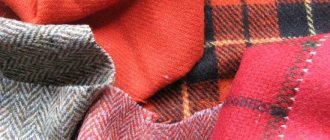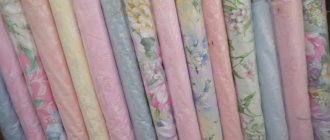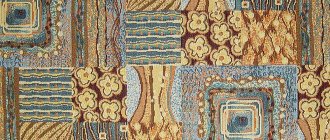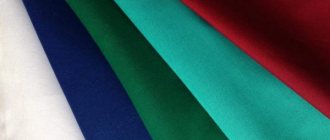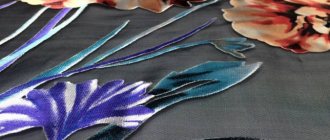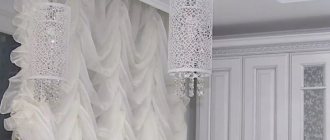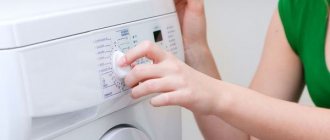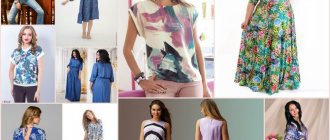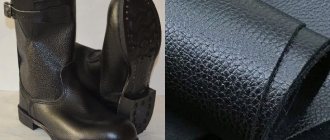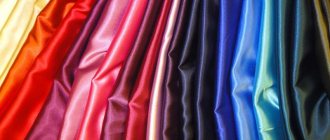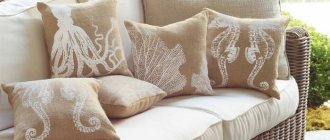Story
Knitwear as a fabric was first produced at the end of the 19th century. Initially, it was made exclusively from artificial materials, but it quickly gained popularity. At this time, a large number of companies picked up this invention and began to implement them in their industries.
What kind of material
Already at the beginning of the 20th century, after a series of developments, artificial silk and viscose appeared. By the end of the century, the production of polyurethane threads was established at the GIPROIV Institute. At the time of rapid development, they tried to use synthetic threads as an experiment in machine knitting. This is how a fabric with unique properties appeared - diving.
Initially, the new fabric was called “sports jersey”, because it was ideally used in the production of sports suits and clothing for active recreation. Now this fabric is used in sewing casual clothes, elegant dresses, and in many other areas.
Diving dress
Application of micro diving material
The designers were especially generous with the outfits of fashionistas: short pencil dresses that fit like gloves, long ones that hang down in beautiful tails.
If diving fabric is used mainly for sports uniforms, tightening and protecting the figure, then microdiving fabric is used to sew both everyday clothes and weekend outfits. Tights, leggings, pants, bodysuits, skirts, gloves, evening dresses, all this and much more.
To increase the decorativeness of the fabric, printed patterns began to be applied to the surface, creating microdiving flock. Having mastered the technology of colorful printing, we launched the production of microdiving prints. The best ballroom and gymnastics costumes today are also made from microdiving.
If you have a problematic figure, you should give preference to tight fitting clothes; they will act as a corset, pulling away the extra centimeters.
Microdiving will help highlight your figure advantages.
Which children's mattress to choose?
Dimensions of 1.5 sleeping set: .
Read reviews about blackout curtain fabric.
Care for thin and delicate skin
Although microdiving is not inferior to its denser counterparts in terms of strength and wear resistance, it must be cared for correctly. Otherwise, you will wear it for a long time, but it will be a rag, not a beautiful thing.
- Wash on a delicate cycle or by hand, at a temperature not exceeding 30°C, polyester, and viscose, have the ability to “shrink” in hot water.
- No bleaches or stain removers, they destroy the fiber structure.
- Instead of spinning, leave the item to drain, this will happen very quickly.
- Dried microdiving is dried in the shade; if it is an evening dress, it is better on hangers.
- Properly washed knitwear does not need ironing.
Lightly soiled items can be lightly rinsed in cool water with your favorite shampoo. And the smell is pleasant, and the softness is like after an expensive mouthwash. The substances included in the shampoo dissolve fat well and do not eat into the fabric.
It’s not the easiest material to care for, but it will more than repay careful handling with a pleasant touch to the body and newness, despite years and wear.
Manufacturing Features
Diving fabric has its own production characteristics - it contains three types of raw materials.
- Viscose. The percentage of this fiber in the fabric is highest - at least 65%. This is explained by the fact that viscose, as a material, is very close to natural, therefore it allows air to pass through well and allows the skin to breathe. In addition, thanks to the fiber, the fabric has its own special shine, similar to satin or silk, or a matte sheen. Viscose itself is made from cellulose.
- Polyester. It contains about half as much as viscose - about 30%. Polyester is a synthetic material that gives divers durability and durability.
- Lycra (elastane, spandex). There is a very small part of it in the fabric - less than 5%. Lycra fibers make the fabric elastic and stretchable.
Material with a matte sheen
In addition to the above-mentioned fibers, cotton is sometimes added to diving (it makes up no more than 10%). This is necessary so that the material can better allow air to pass through and make the body comfortable. This is true, for example, for summer clothes.
You might be interested in this Interesting facts about modal fabric: is it a natural material
The fabric is produced by knitting fibers. Depending on this indicator and the percentage of different types of threads, the resulting fabric may have a higher or lower density.
The production of diving crepe (a type of diving fabric) is slightly different. A crepe thread is woven into it. Because of this, the fabric has a slightly rough texture. Crepe is made from very twisted threads, which are clearly visible up close. This gives the material a special density with minimal thickness.
Diving tracksuit
Crepe diving
Crepe diving is a composite material that combines the elasticity of diving and the high strength of additional large twist threads. Dense elastic fabric with a matte sheen, pleasant to the touch, has a wavy rough texture with a smooth backside. It is easy to wash, as the twisted fibers do not allow dirt to pass through.
The elastic, soft fabric gives freedom of movement and is great for people leading an active lifestyle. Suits for divers and circus performers, fitness clothing, swimsuits, leggings, and tights are made from it.
The edges of the fabric do not fray , the fabric drapes easily, which allows you to sew complex products from diving crepe and use it for decoration. Modern business women appreciate high-quality material, because dresses and suits made from this material look perfect all day long and perfectly correct the figure.
Designers create amazing models of elegant and casual dresses and blouses from soft, beautiful material in combination with other materials. Elegant models with lace inserts are very popular. Here, of course, guipure is indispensable, which gives the products a special chic. It is extremely successful to combine diving and stretch guipure, as two identical materials with properties to stretch and return to their original form.
Material properties
It’s not for nothing that diving fabric is considered unique. It has a lot of interesting properties:
- elasticity;
- perfect smoothness;
- good fit;
- wear resistance;
- crease resistance;
- creating a tightening effect;
- ability to pass air;
- hypoallergenic.
Due to all these properties, diving becomes a quality material for many types of clothing.
Everyday dresses
Types of matter
Diving is divided into several types. Each of them has its own characteristics and properties. All types of diving are suitable for a certain type of product.
- Microdiving. Particularly thin and light material with low density. It is suitable for summer clothes and dressy suits.
- Crepe diving. Very similar to microdiving. A smooth material that has a production feature - weaving twisted crepe threads. Most often used for sewing suits, dresses, leggings.
Crepe diving
- Diving. Particularly durable material that hugs the figure and highlights its features well. Accordingly, it is used for leggings, tights, and shapewear.
- Diving on fleece. It has a dense structure and hairiness on the inside. Especially relevant for winter outdoor activities.
- Diving flock. Low density fabric with a printed pattern.
Microdiving leggings
What's included
Typically this material consists of three types of raw materials.
- Viscose. Percentage composition from 65%. Viscose is obtained from cellulose. These fibers are the closest to natural fibers; they ensure the breathability of the material. When viscose is added, the fabric acquires either the shine of satin, or the shine of silk, or the matte light characteristic of cotton fabrics.
- Polyester, about 30%. These synthetic fibers guarantee the strength of the fabric and its durability.
- Lycra, no more than 5%. The material is also known as elastane. It is sometimes called neolan, spandex or vorin. Fibers are responsible for the elasticity of the product and its ability to stretch.
- Sometimes cotton is added to the diving composition, but not more than a tenth. It increases the breathability of the material.
Another option for mixed material is diving crepe. What kind of fabric is this? Reviews about this material are extremely positive. Let's give a brief description of this material to understand what it is? Look at the photo to see what she looks like.
Read about: description of Oxford fabric: these are durable backpacks and tents
In essence, this fabric is a diving material with a dense crepe thread woven into it. Upon closer inspection, you can even notice the finely patterned weave. The material is slightly rough to the touch, however, it is soft and elastic. Diving crepe perfectly allows moisture and air to pass through, is easy to wash and does not need ironing.
Modern production has mastered the production of two types of fabric:
- This is a microdiving fabric that has a lower density. Summer clothes are made from it.
- As for tight diving, it is good for the autumn-spring season; it is also used to make shapewear and products that shape a beautiful figure.
What material is it made from?
Diving has a very wide range of applications. The most popular types are microdiving and diving. These fabrics are good for their versatility. In addition to everyday clothes, they are used to make a large number of accessories (for example, gloves, shapewear or tights).
Diving is particularly popular as a material for scuba diving. It doesn't rub anywhere and fits like a second skin.
Costume
Due to its properties, the fabric is ideal for overweight people, which is why clothes of large sizes are often made from it. Diving can slim your figure and make it more attractive.
You might be interested in this. Features of matting: what is the fabric made from?
In general, the material is ideal for bodysuits, skirts, shorts, dresses, suits and even evening wear. Of course, it remains the main fabric for its intended purpose - sportswear.
In terms of quality, the best products are made from Turkish or Italian material, although Chinese and Korean are much more common on the market.
Men's surf suit
Care: incredibly simple
- Taking care of your diving gear is extremely easy. They are washed in lukewarm water (at 30°C) by hand or in a gentle washing machine.
- There is no need to wring out the products - just let the water drain after washing.
- The fabric does not wrinkle, so there is no need to iron it.
- Practical and stylish diving designed for beauty and health. Shapewear will visually lose you several kilograms and give a beautiful silhouette to your figure. And regular fitness classes, swimming, cycling and fashionable, comfortable sportswear will keep your spirit and body young for a long time.
The video shows Lurex fabric on diving:
© 2021 textiletrend.ru
Fabric care
From the description of the diving fabric, it is quite clear that it is truly universal, and this makes it extremely easy to care for. Recommendations:
- Wash in cool water (no more than 30 degrees), preferably by hand. If you do wash it in a machine, use the delicate cycle.
- diving products must not be bleached;
- Do not overuse the spin cycle, the material dries quickly on its own;
- do not iron, diving products do not wrinkle;
- Avoid prolonged exposure to direct sunlight.
If you follow all these points, the products will last an incredibly long time.
Women's dive suit
Strengths and weaknesses of the material
The undoubted advantages of diving include ease of everyday use.
- Comfortable to wear. The products are pleasant to the body, tightly fit the silhouette without restricting movement.
- Easy to care for. Clothes do not wrinkle, do not shrink, and are easy to wash.
- Stability in wearing. The fabric is dense, does not cling and practically does not tear.
- Easy to process when sewing clothes.
The disadvantages include 4 facts.
- Fabric, especially thick diving fabric, does not allow air to pass through well.
- The material is fire resistant. A spark hits the item and instantly burns through it.
- Products cannot be boiled or dried on a radiator. High temperatures destroy synthetic fibers, causing the fabric to wrinkle and deform.
- The canvas is afraid of direct sunlight. With prolonged exposure, stains will form.
Advantages and disadvantages
Like any other material, diving has its pros and cons.
Strengths of the fabric:
- tightening effect (relevant both for emphasizing advantages and hiding flaws);
- elasticity, which allows you to feel free while playing sports;
- due to the structure, no pilling or abrasions are formed;
- has long-lasting colors;
- does not wrinkle at all;
- does not rub the skin, no matter how tightly it fits;
- if damaged, the arrow does not diverge;
- ease of care;
- environmental friendliness;
- maximum strength.
Printed leggings
Weaknesses:
- despite the fact that the material is breathable, it is still made of synthetic materials, so such products are not recommended to be worn very often;
- may not be suitable for people with an allergic reaction to synthetics;
- may become deformed when exposed to high temperatures.
Melange diving
Composition and properties
Diving includes several materials:
- Up to 70% is viscose, which allows the skin to breathe, as it allows air to pass through well. The shine on the surface of the fabric is similar to satin or silk. Viscose, in turn, consists of cellulose.
- Up to 20-30% of all diving is made of polyester. It is responsible for durability, dense, non-transparent structure.
- Less than 5% usually falls on elastane or lycra, this allows the fabric to stretch better.
In some cases, manufacturers add up to 10% cotton to the total composition, then the amount of polyester is slightly reduced.
Recently, diving fabric has become popular due to its special properties:
- hypoallergenic material;
- it lasts a long time, it is wear-resistant, durable;
- environmentally friendly;
- drapes easily;
- does not shrink after several washes;
- does not wrinkle, does not fade, has no odors.
